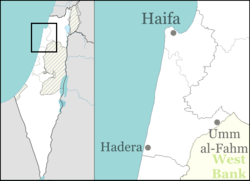Harish, Israel
- Katzir-Harish redirects here. For the separated town, see Katzir.
Harish
| |
|---|---|
| Hebrew transcription(s) | |
| • ISO 259 | Ḥariš |
 | |
 Harish | |
| Coordinates: 32°29′21″N 35°6′28″E / 32.48917°N 35.10778°ECoordinates: 32°29′21″N 35°6′28″E / 32.48917°N 35.10778°E | |
| District |
|
| Founded | 1982 |
| Government | |
| • Type | Local council |
| Area | |
| • Total | 9,736 dunams (9.736 km2 or 3.759 sq mi) |
| Population (2017)[1] | |
| • Total | 3,582 |
| • Density | 370/km2 (950/sq mi) |
| Name meaning | Ploughed furrow |
Harish (Hebrew: חָרִישׁ pron. ha-reesh) meaning "ploughed furrow", is a town (local council) in the Haifa District of Israel. Its jurisdiction is 9,736 dunams.[2] It is currently being expanded into a city projected to eventually have a population of 100,000. In 2017 it had a population of 3,582.[1] It is expected to attain a population of 25,000 in 2017.
History


Harish was founded as a Nahal settlement in 1982 and converted into a kibbutz in 1985. The kibbutz failed to take off, and was abandoned by its residents in 1993, leaving only a Border Police detachment behind. Subsequently, it lost its kibbutz status and became a regular town. The Housing Ministry invested heavily in its infrastructure and development, and it became a town of about 300 housing units. The government sold off the apartments to career army officers, but most of them never actually moved there.[3] During the same period, it was merged with neighouring Katzir to form a new town, Katzir-Harish.[4] However, they were split in 2012, with Harish remaining a town, and Katzir reverting to the jurisdiction of Menashe Regional Council.
Throughout the 1990s, young Israelis moved to Harish, attracted by low cost of housing. Many of these new residents were young and secular, but in 2003, about 50 Garin Torani families moved to the town. In addition, an Arab Bedouin clan from Ramla was moved to Harish in order to end a bloody feud with another clan.[5]
In 2007, Israeli Housing Minister Ariel Atias decided to turn Harish into a city of 100,000. It was originally planned that it would be a Haredi city.[6] The plans to turn it into a Haredi city caused secular residents led by Hemi Bar-Or to petition the Israeli Supreme Court against the plan, arguing that they would be unable to continue to live there if it became Haredi. The Supreme Court ruled that housing tenders would have to be offered to all residents of Israel. Shortly afterward, housing tenders were put on offer, and an organized effort to have secular Israelis buy them up bore fruit among young Israelis looking for affordable housing and bicycle enthusiasts attracted to the nearby forests as a cycling destination on weekends.[3] In 2012, a secular buyers group organized to bid on lots zoned for 400 housing units there.[7]
The master plan of Harish was prepared by the architecture firm Mansfeld-Kehat Architects and calls for the expansion of Harish to Highway 65 in the north, and Baqa al-Gharbiyye in the south.[8]
By August 2015, construction was well underway, with many buildings nearing completion.[3] In January 2016, the Israeli cabinet approved a 1 billion NIS plan to develop Harish. The plan calls for Harish to be turned into a city of 50,000 in three years, with the eventual goal of attaining a population of 100,000. Under current plans, Harish will be expanded to the northeast, with residential areas in particular being expanded to achieve further population growth, with a business zone, hotel, 600 dunams of public parks and gardens, and a special site consolidating all emergency services planned.[9] It is being built as a smart city, with full WiFi coverage and its own fiber optic cables, LED streetlights with sensors, camera-equipped lampposts, and smart trash cans that will signal trucks through the Internet when they need to be emptied.[3] A 60 meter wide main boulevard will be built with an island in the middle lined with bicycle paths, benches, and small cafes. It has also been suggested that a light rail line may be built in the future.[3]
References
- 1 2 "List of localities, in Alphabetical order" (PDF). Israel Central Bureau of Statistics. Retrieved August 26, 2018.
- ↑ "Local Authorities in Israel 2005, Publication #1295 - Municipality Profiles - Katzir-Harish" (PDF) (in Hebrew). Israel Central Bureau of Statistics. Retrieved 2008-08-01.
- 1 2 3 4 5 http://www.timesofisrael.com/as-harish-rises-some-wonder-if-it-can-break-suburban-mold/
- ↑ HaReuveni, Immanuel (1999). Lexicon of the Land of Israel (in Hebrew). Miskal - Yedioth Ahronoth Books and Chemed Books. p. 840. ISBN 965-448-413-7.
- ↑ http://www.al-monitor.com/pulse/tr/contents/articles/originals/2013/07/harish-fight-israeli-ghost-town.html
- ↑ http://www.haaretz.com/print-edition/business/a-haredi-city-on-the-horizon-1.373785
- ↑ Secular Israelis make move on new city Harish
- ↑ "Harish Master Plan, 2007". Mansfer-Kehat Architects. Retrieved 2016-09-27.
- ↑ http://jpupdates.com/2015/12/20/israels-cabinet-approves-one-billion-shekalim-for-new-city-of-harish/